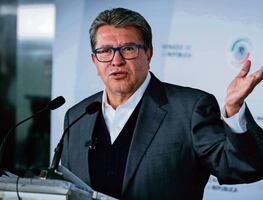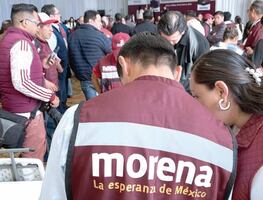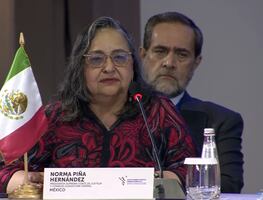Más Información

Alistan comparecencia de Harfuch, Rosa Icela y Gertz Manero ante el Congreso; Monreal anuncia la primera fecha

Morena se suma al rechazo del impuesto a remesas en EU; "es una agresión a la dignidad y doble tributación": Luisa Alcalde

INE rechaza más de 38 mil solicitudes de observadores electorales para elección judicial; 20 mil eran afiliados a Morena
Yesterday, six years after the enforced disappearance of the 43 Ayotzinapa students , Human Rights Minister Alejandro Encinas said authorities made 80 arrests in connection with the case.
During an event at the National Palace, where the victims’ families were present, Encinas said those arrested were members of the Guerreros Unidos cartel, as well as federal and state police officers.
Between March and September, authorities obtained 70 arrest warrants on organized crime and enforced disappearance charges.
Encinas explained the current administration has carried out 30 search operations in 217 locations in six townships in Guerrero. Authorities made important discoveries during five search operations, including the exhumation of six bodies in Cocula and Barranca del Tigre, and 21 bodies inside several mass graves. So far, authorities have identified six bodies, although they are not the missing students.
Encinas also said that since the search began for the 43 students, some 245 bodies have been found in the area. Only 22 have been identified.
Meanwhile, special prosecutor Omar Gómez Trejo announced the arrest of former government official Blanca Alicia "N," who allegedly distorted Tomás Zerón ’s actions at the San Juan River in Cocula. He added that Blanca Alicia "N" faces torture and enforced disappearance accusations and she remains in federal prison. He explained that:
“Blanca Alicia, who signed [an official document], never went to the San Juan River because she was in Mexico City all the time, at the SEIDO headquarters. This is transcendental because in that official record [authorities] tried to pretend they found the skeletal remains of missing student Alexander Mora Venancio, this is the only material indication that supports the version created by the PGR.”
Trejo also accused Blanca Alicia of hiding the students’ location.
Gómez said that among those being sought are “the intellectual and material authors of the disappearance, and these orders include police from various municipalities, federal police, members of the army,” as well as current and former officials from the federal prosecutor’s office and organized crime. He did not say if that included the office’s former chief, Jesús Murillo Karam, who Gertz Manero accused of “orchestrating a massive media trick.”
Attorney General Alejandro Gertz Manero said Tomás Zerón de Lucio, the case’s former chief investigator, embezzled MXN 1,000 million from the PGR in collaboration with others. He added the situation was allowed by his superiors.
“Those responsible for the forced disappearance of the 43 students in the south of the country are fully identified” and will be prosecuted, unlike the manipulation and cover-up that happened under the previous administration, said Attorney General Alejandro Gertz Manero on the sixth anniversary of their disappearance.
During the event at the National Palace, Gertz Manero said Zerón de Lucio is the one who orchestrated the “lies and falsehoods" regarding the Ayotzinapa case.
On Saturday, Gertz Manero said, “the missing youths were victims who ended up in the middle of a battle of interests between drug trafficking forces.” Iguala has long been a critical hub for moving heroin from opium poppies grown in the surrounding mountains north to the United States.
He said that in addition to the missing students, others were killed in the area that night. “Nearly 80 people were massacred and hidden in Iguala by the different criminal groups and their official accomplices,” he said.
Gertz Manero said he considers that a “generalized cover-up” has been established. It led to arbitrary arrests and torture.
When President Andrés Manuel López Obrador spoke at the event, he made one of the most shocking revelations: authorities have issued arrest warrants against soldiers who were allegedly involved in the enforced disappearance of the 43 Ayotzinapa students.
The Mexican President also apologized for the disappearance of the 43 students and described the incident as an “injustice perpetrated by the Mexican government.”
The students’ families have long demanded that soldiers be included in the investigation. Local police, other security forces, and members of a local drug cartel abducted the students in Iguala, Guerrero on the night of September 26.
It occurred near a large army base and independent investigations showed members of the military were aware of what was happening. Pursuing soldiers is a significant move, especially considering President Andrés Manuel López Obrador’s coziness with the armed forces.
The motive for the students’ abduction remains a subject of debate.
Six years in, not knowing for certain what happened to the students has left the families desperate. Moving against the military is at least symbolically significant.
María Martínez, the mother of one of the missing students, who spoke for the other families said she asked that the government “squeeze a little more,” because the families are “mad with pain.”
During the Peña Nieto administration, authorities said the students were killed and incinerated at a garbage dump outside the nearby town of Cocula. They said their remains were tossed in a river. However, the version was largely based on statements made under torture and independent investigators did not find evidence to support the story.
The highest-ranking fugitive in the case is Tomás Zerón, who at the time of the abduction was the head of the Federal Investigation Agency. He is being sought on charges of torture and covering up enforced disappearances. Gertz Manero said that Zerén was in Israel and that Mexico had asked that government for help in his arrest.
New revelations
Alejandro Encinas revealed new information regarding the case on the sixth anniversary of the enforced disappearance. According to Encinas, the 43 students were not together at the time of their disappearance .
Encinas said the current administration discovered this information after analyzing hundreds of official documents, classified videos, and reports that were hidden by several government departments.
The government official added authorities have met with whistleblowers, survivors, police officers, government officials, journalists, human rights activists, landowners, miners, street vendors, and criminals.
Moreover, the Mexican government created a scientific committee for the case, which is formed by the National Guard, the Interior Ministry, the National Intelligence Center, and the National Science and Technology Council.
These institutions have analyzed 80 million phone records dated between 2014 and 2018. They have found significant information regarding the 2014 incident.
gm




